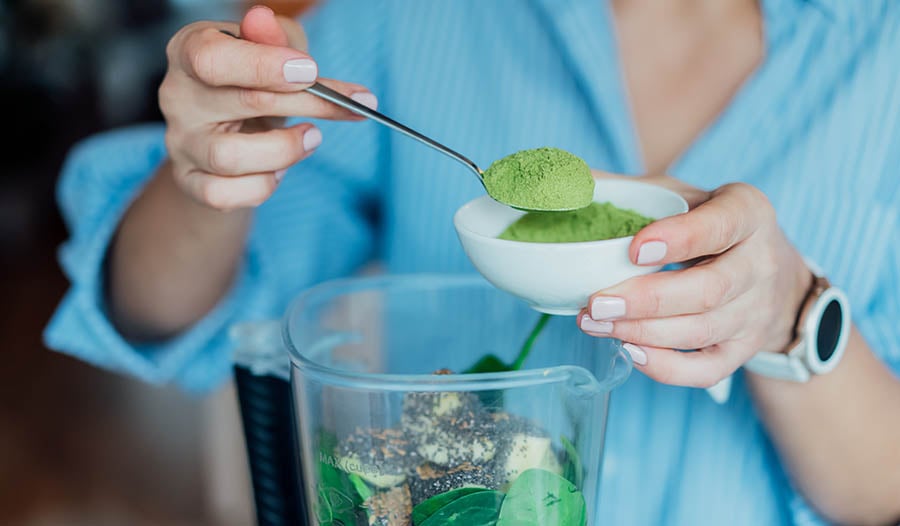Do You Need a Greens Powder? Here’s What You Need to Know

Greens can play a major role in eating a healthy diet, managing a healthy weight (or losing some pounds), and feeling good. However, many people fail to get enough greens in their diets.
Slowly, that’s been changing, with green juice becoming more popular than ever (especially with juicers becoming much cheaper today) and supergreen powders becoming one of the most sought-after supplements.
While you can get your greens through leafy greens and other green vegetables, super green supplements offer the next level of green nutrition content, as they can pack in more variety of ingredients plus vitamins, minerals, and antioxidants than simply food alone. This means better support for digestion, healthy energy levels, detoxification, and more. Learn more below, including ways to get more green into your daily life.
Note that it is important to consult a healthcare professional prior to beginning any new dietary or lifestyle regimen.
What Are Greens?
Typically, leafy greens are referred to as greens. These leaf vegetables or dark leafy greens include a wide range of plant species characterized by their tender, edible leaves. Common lettuce varieties, spinach and kale make up just a few of these greens.
In general, dark leafy greens are considered more nutrient-dense than their lighter counterparts. Think Swiss chard, kale, collard greens, mustard greens, and turnip greens. These can be used in green juice recipes but are also hardy enough to be cooked in various recipes for nearly every cuisine.
Dark leafy greens also appear in many “green superfood powders” along with ingredients like alfalfa, oats, dried algae, berries, and herbs, which have been deemed “superfoods” because they are exceptionally high in nutrients, including phytochemicals and antioxidants.
Benefits of Greens
Consuming greens offers many health benefits, as these vegetables are packed with vitamins and minerals that are key in maintaining overall health and supporting various bodily functions. Plus, the high antioxidant content in leafy greens makes them nutritional powerhouses, meaning that these supplements may help fill in gaps in your diet, especially if you don’t regularly eat vegetables and fruits.
Furthermore, their low calorie and high fiber content make them ideal for promoting healthy weight management and supporting proper digestion, keeping you feeling full and satisfied while supporting your digestive system.
The benefits of adding super greens powder to your diet can include:
- Easy way to get greens
- Support a healthy immune system
- Increases antioxidant intake
- Help with healthy detoxification
- Supports healthy digestive function
- Support for general gut health
- Reduces occasional constipation, gas, and bloating
- Supports energy levels
- Makes a great addition to most types of healthy diets that can help you get the nutrients you need to help support a healthy weight.
Another benefit is that super greens are suitable for people following a variety of diets, including Paleo, low-carb or keto, vegan, and vegetarian, and for those on diets where they are limiting gluten, nuts, or dairy.
What Are The Best Greens?
When it comes to selecting the best greens for your diet, the more different kinds you use, the better in terms of nutrients as well as flavors. Here are some of the top greens:
- Spinach — this versatile green is rich in iron, folate, and vitamin K; can eat raw or cooked.
- Kale — featuring a robust flavor, it’s packed with vitamins A, C, and K, along with antioxidants like lutein and zeaxanthin; baby kale can be consumed raw, while most kale is better cooked.
- Swiss chard — with its vibrant rainbow-colored stems and earthy flavor, it’s rich in vitamins as well as magnesium and potassium; it does well in cooked dishes.
- Collard greens — A southern staple, collard greens are loaded with vitamin C and fiber, too.
- Arugula — this peppery green adds a kick to salads and offers a good amount of vitamin K, folate and calcium.
- Lettuces — varieties differ slightly in taste and nutrition, but most are high in vitamins A and K, along with folate.
- Mustard greens — these pungent and spicy leaves are rich in vitamins A, C, K and calcium; they do well in cooked dishes.
- Watercress — great in salads, it has peppery, bite-sized leaves with a high concentration of vitamins A, C and K. .
- Turnip greens — slightly sweeter than collard greens, these are rich in vitamins A, C, K and calcium.
- Bok choy — this mild-flavored Asian green with white stalks and dark green leaves is one of the most nutrient-dense leafy greens; it is featured in many Southeast Asian dishes.
- Dandelion greens — with slightly bitter leaves, they can be enjoyed raw or cooked or added to sauces and dips.
- Beet greens — the dark green tops of beetroot plants, beet greens are good in cooked dishes.
- Radish greens — while many people toss away the leaves of the radish, it really is a good source of micronutrients and can be put into salads as well as cooked recipes.
How to Add Greens to Your Diet
Incorporating greens into your daily meals is easier than you might think. Here are some simple yet creative ways to enjoy these nutritional powerhouses:
- Salads: This is a classic, but don't be afraid to experiment! Mix and match different leafy greens with fruits, nuts, seeds and lean protein for a satisfying meal.
- Juice: A blend of mostly green veggies (such as Swiss chard, kale, spinach, cucumber, celery and parsley) that are juiced together into a healthy drink. May also use a green apple, pear or lime in a green juice.
- Smoothies: Blend spinach or kale with fruits and yogurt for a quick and refreshing green smoothie.
- Soups and Stews: Throw handfuls of chopped leafy greens into your next pot of soup or stew for a nutrient boost.
- Stir-fries: Leafy greens can be a healthy addition to stir-fries, wilting beautifully alongside other vegetables and protein.
- Frittatas and Omelets: Add chopped greens to your morning omelet or frittata for a protein-packed and veggie-filled breakfast.
- SuperGreens supplement: You can add Organic SuperGreens Powder to your favorite smoothie recipes.
How To Choose A Greens Powder
Some supergreens go above and beyond by adding dried fruits, adaptogens such as ashwagandha, probiotics such as Bacillus coagulans, and digestive enzymes such as amylase and lipase. These ingredients are added to support overall gut health, which assists in the process of absorbing nutrients in addition to promoting healthy digestive function and maintaining healthy gut microflora.
Look for super greens that are USDA Certified Organic, meaning all ingredients are grown in nourishing, high-quality soil in which no prohibited pesticides, herbicides, or processing agents are allowed to be used. How many times a day can you drink super greens? Typically, one or two servings daily is recommended since each small serving packs a big punch of nutrients.
DISCLAIMER:This Wellness Hub does not intend to provide diagnosis...













































































 Table of Contents
Table of Contents


